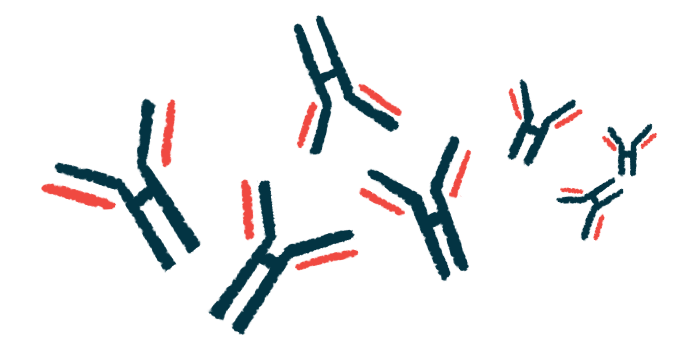Antibodies Against Viral Protein Tied to Better Survival Rate in ALS
Findings support therapeutic potential of GeNeuro's GNK301 for ALS

Higher blood levels of antibodies against the viral protein HERV-K ENV are associated with a better survival rate and improved outcomes in people with amyotrophic lateral sclerosis (ALS), a new study shows.
These findings further support the therapeutic potential of GNK301, an experimental antibody against HERV-K ENV being developed for ALS by GeNeuro, the company reports.
The study, “Antibody Response to HML-2 May Be Protective in Amyotrophic Lateral Sclerosis,” was published in the Annals of Neurology.
The work is the result of a collaboration between GeNeuro and the National Institute of Neurological Disorders and Stroke (NINDS), which funded the study along with the ALS Association. NINDS is part of the National Institutes of Health in the U.S.
Investigating the genetics of ALS
About 8% of the human genome — which encodes the genetic instructions for human beings — derives from ancient infections of retroviruses, a type of virus that inserts its genetic information into the host’s DNA. Emerging evidence suggests that reactivation of these integrated viral elements, called human endogenous retroviruses, may play a role in ALS and other diseases.
HERV-K ENV, also known as HML-2 ENV, is an outer shell protein of the human endogenous retrovirus K. While this protein is not usually produced in human cells, evidence suggests it may be reactivated in people with ALS.
Previous results from the GeNeuro and NINDS collaboration showed that this endogenous retroviral protein is detectable in the fluid around the brain of most ALS patients, and that it has toxic effects on nerve cells.
“Our pre-clinical work on ALS has evidenced that HERV-K ENV mediates toxicity via three interlinked pathways, leading to neuronal cell death,” Avindra Nath, MD, clinical director at NINDS, said in a press release from GeNeuro.
“GeNeuro’s GN-K01 antibody has demonstrated to neutralize this effect in pre-clinical” models, Nath said.
In the new study, scientists tested for the presence of antibodies against HERV-K ENV in the blood of 243 ALS patients and 242 age- and sex-matched healthy donors. The ALS patients were comprised of 140 men, 99 women, and four individuals of unknown sex; their mean age was 58.89.
Blood from 85 people with multiple sclerosis (MS), another neurodegenerative disease, also was included in the analysis.
Results showed that average levels of antibodies against the viral protein were significantly higher among ALS patients than in the other two groups. More than half (55.14%) of ALS patients tested positive for antibodies against HERV-K ENV, compared with 21.16% of healthy participants, and 13.1% of MS patients.
Notably, no significant differences were detected between ALS patients and healthy people in terms of total levels of IgGs, a type of antibody involved in the fight against infections.
This suggested that the observed group differences in the levels of anti-HERV-K ENV antibodies were not the result of a general imbalance in antibody production in ALS patients.
Blood levels of the viral protein itself also were significantly higher in ALS patients relative to healthy donors, in line with prior research.
These results highlight that higher levels of antibodies against HERV-K ENV are “likely due to persistent [exposure to the viral protein] following reactivation of the viral genes,” the researchers wrote.
The impact of HERV-K ENV
Among the ALS patients, levels of antibodies against HERV-K ENV did not vary by sex or ethnic background. However, these levels were slightly, but significantly, lower among patients with definite ALS, compared with those in whom an ALS diagnosis was likely but not technically confirmed.
“Since the degree of certainty of the diagnosis is based on the degree of spread of the disease (definite ALS diagnosis requires upper and lower motor signs in at least three regions), this observation suggests that antibody levels decrease in later stages of the disease,” the researchers wrote.
In further analyses, the ALS patients were divided into three groups according to their anti-HERV-K ENV antibody levels. The third of patients with the lowest antibody levels showed a significantly shorter median survival relative to the other two thirds with higher levels (36 months vs. 50–51 months).
However, no significant association was detected between antibody levels and scores on the ALS Functional Rating Scale Revised, a measure of ALS symptom severity, or with rate of disease progression.
Collectively, the data suggest that an antibody response against HERV-K ENV “would be protective for [ALS] patients, or conversely, a loss of antibodies is associated with a poor prognosis,” the researchers wrote.
They noted, however, that it is impossible to conclude from these data whether there is a cause-and-effect relationship between antibody levels and ALS prognosis.
Still, these findings support the idea that a therapeutic antibody targeting HERV-K ENV may be useful as a treatment modality in ALS. Using vaccines to prompt the body to make more antibodies against the viral protein also was noted as a potential therapeutic strategy.
Hervé Perron, PhD, scientific director of GeNeuro, said the results “support and confirm the relevance of GeNeuro’s approach to sporadic ALS via its novel monoclonal antibody that inhibits the neurotoxic effects of the HERV-K ENV protein.”
“We now want to move forward as quickly as possible to provide what could be a prospective life-changing treatment for patients,” Perron added.








